SDTEST® has 38 different VUCA polls that calculate the 13,643 correlation values between stages of development according to the theory of Spiral Dynamics and answer options of these 38 polls.
We invite curiosity about the systemic mechanisms behind this correlation. There may be hidden variables that provide alternative explanations.
In our analysis of the poll "How Do You Regulate Your Emotions?" (by Nawal Mustafa [1]), we found an intriguing negative (linear/nonlinear) correlation that warrants closer examination:
-0.1330 (Pearson) between the When I feel REJECTED. I will acknowledge that this feeling sucks, but I will not let it consume me. Rejection is redirection. / Strongly Agree and the Purple stage.
The critical value of the correlation coefficient for a normal distribution, by William Sealy Gosset (Student), is r = 0.1013. Nevertheless, this negative linear correlation of -0.1330 meets the reliability criteria but does not necessarily imply causation.
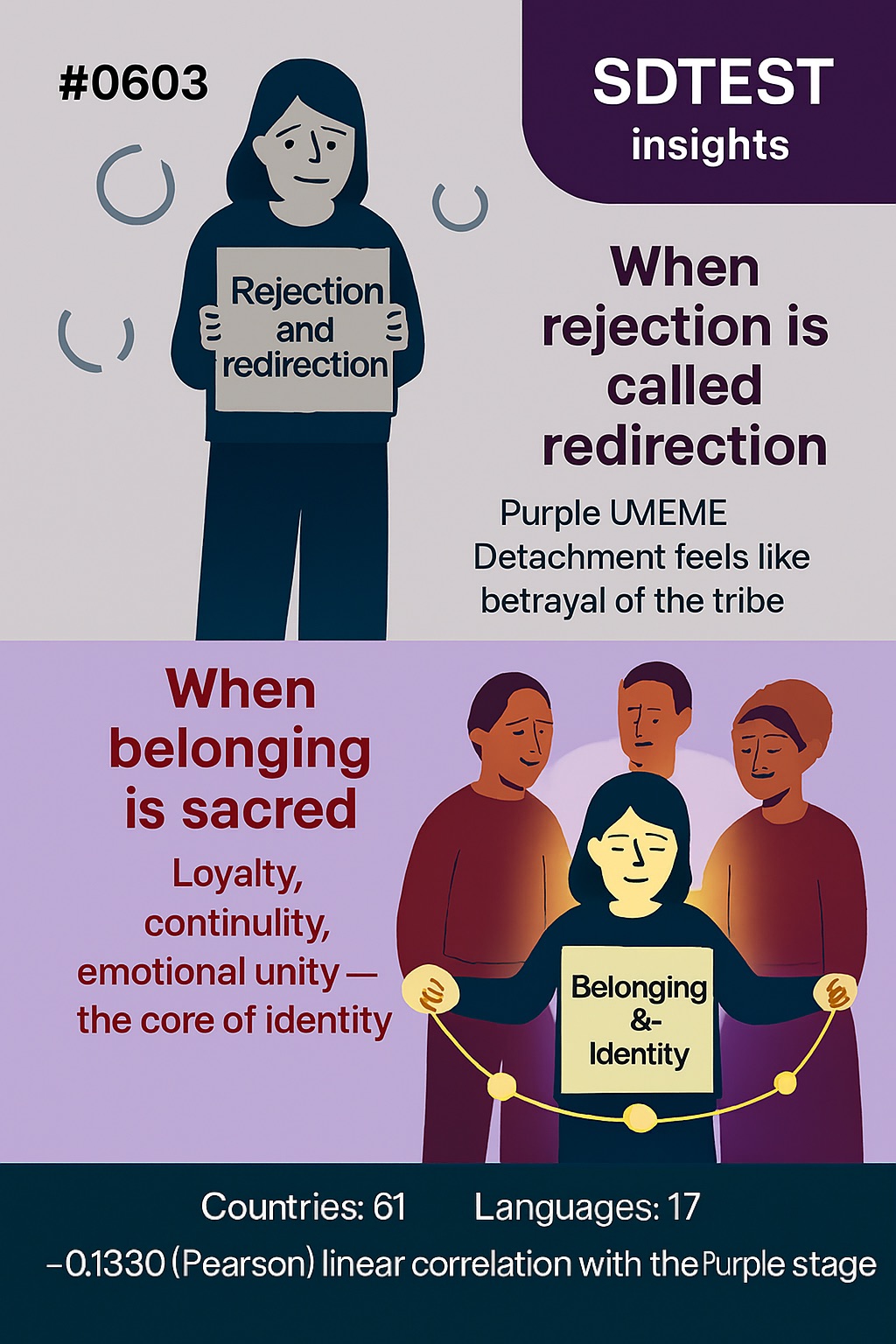
This negative correlation of -0.1330 between "When I feel REJECTED. I will acknowledge that this feeling sucks, but I will not let it consume me. Rejection is redirection. / Strongly Agree" and the Purple stage offers profound insights when viewed through the lens of the Purple value system:
Organizational Perspective:
Organizations operating within the Purple mindset might interpret this correlation as:
- Validation of their understanding that rejection from the tribal community represents a spiritual catastrophe that cannot be dismissed through individual emotional regulation techniques
- Confirmation that their ancestral wisdom recognizes rejection as potential evidence of divine displeasure or violation of sacred taboos that requires ritual intervention rather than personal reframing
- Evidence supporting their belief that organizational belonging flows from supernatural forces and tribal acceptance that transcends individual attempts to rationalize or redirect rejection experiences
These organizations might respond by:
- Implementing traditional ritual ceremonies and spiritual cleansing practices to address rejection rather than encouraging individual emotional management strategies
- Consulting with spiritual elders and ancestral wisdom keepers to interpret organizational rejection as messages from supernatural forces requiring a collective response
- Creating tribal healing circles and community ceremonies that address rejection through group support and divine intervention rather than individual cognitive reframing
Team Perspective:
Teams operating from a Purple mindset might approach this correlation by:
- Viewing it as an affirmation of their collective understanding that team rejection represents a profound spiritual wound that threatens the mystical bonds connecting the tribal community
- Interpreting it as support for their belief that rejection within the team indicates disruption of sacred harmony that requires ritual healing rather than individual emotional regulation
- Seeing it as validation for their understanding that team belonging emerges through supernatural grace and ancestral blessing rather than personal resilience and cognitive redirection
These teams might respond by:
- Conducting traditional healing rituals and spiritual ceremonies to restore harmony when team members experience rejection, rather than promoting individual emotional management
- Seeking guidance from spiritual advisors and tribal elders to understand rejection as a manifestation of ancestral displeasure or divine testing of tribal unity
- Creating collective support systems based on spiritual practices, myth-telling, and ritual bonding rather than encouraging individual emotional regulation and reframing techniques
Individual Perspective:
Individuals aligned with the Purple value system might interpret this correlation as:
- Personal validation of their deep spiritual understanding that rejection represents potential disconnection from ancestral favor and divine protection that cannot be overcome through individual mindset shifts
- Confirmation that their traditional worldview correctly recognizes rejection as a possible indication of spiritual imbalance or violation of sacred customs requiring supernatural intervention
- Evidence supporting their understanding that personal worth and direction flow from tribal acceptance and divine will rather than individual emotional regulation and cognitive redirection
These individuals might respond by:
- Seeking spiritual guidance from traditional healers and ancestral spirits to understand rejection as a message from the supernatural realm requiring ritual response
- Participating in traditional ceremonies, offerings, and spiritual practices to restore divine favor and tribal connection rather than relying on individual emotional management
- Viewing rejection through the lens of ancestral wisdom, spiritual testing, and divine mystery rather than accepting contemporary concepts of personal redirection and resilience
This negative correlation, viewed through the Purple lens, suggests that those operating at the Purple level may be significantly less likely to embrace individual emotional regulation approaches to rejection. It implies that the Purple value system's emphasis on tribal belonging, spiritual guidance, and ancestral wisdom creates resistance to modern concepts of personal emotional management and cognitive reframing.
The reasons why people might less strongly agree that "Rejection is redirection" in the Purple stage could include:
- Sacred Community: Rejection from the tribal community represents a profound spiritual crisis that cannot be resolved through individual reframing or emotional regulation techniques
- Divine Will: Understanding that acceptance and rejection flow from supernatural forces and ancestral blessing rather than personal opportunity or redirection toward individual goals
- Spiritual Significance: Recognition that rejection may indicate violation of sacred taboos or loss of divine favor requiring ritual intervention rather than cognitive redirection
- Collective Identity: Personal worth emerges from tribal belonging and spiritual connection rather than individual resilience and ability to reframe rejection experiences
- Ancestral Guidance: Life direction comes from spiritual wisdom and tribal customs rather than personal interpretation of rejection as redirection toward individual paths
This correlation prompts us to consider how traditional, spiritually-oriented value systems influence approaches to emotional regulation and personal resilience. It raises questions about whether Purple-stage individuals experience rejection as a fundamentally different phenomenon that requires collective and spiritual response rather than individual cognitive management.
Ultimately, this correlation highlights the complex interplay between spiritual beliefs, tribal identity, and emotional processing approaches. From a Purple perspective, rejecting the concept that "rejection is redirection" might be seen not as emotional immaturity but as profound spiritual wisdom that recognizes rejection as sacred communication requiring tribal support, ritual healing, and divine intervention rather than individual emotional regulation and personal reframing.
In our analysis of the poll "Gender difference in building self-confidence" (IFD Allensbach), we found an intriguing positive linear correlation that warrants closer examination:
0.1369 (Pearson) between the Own attractiveness and the Red stage.
The critical value of the correlation coefficient for a normal distribution, by William Sealy Gosset (Student), is r = 0.1014. Nevertheless, this positive linear correlation of 0.1369 meets the reliability criteria but does not necessarily imply causation.
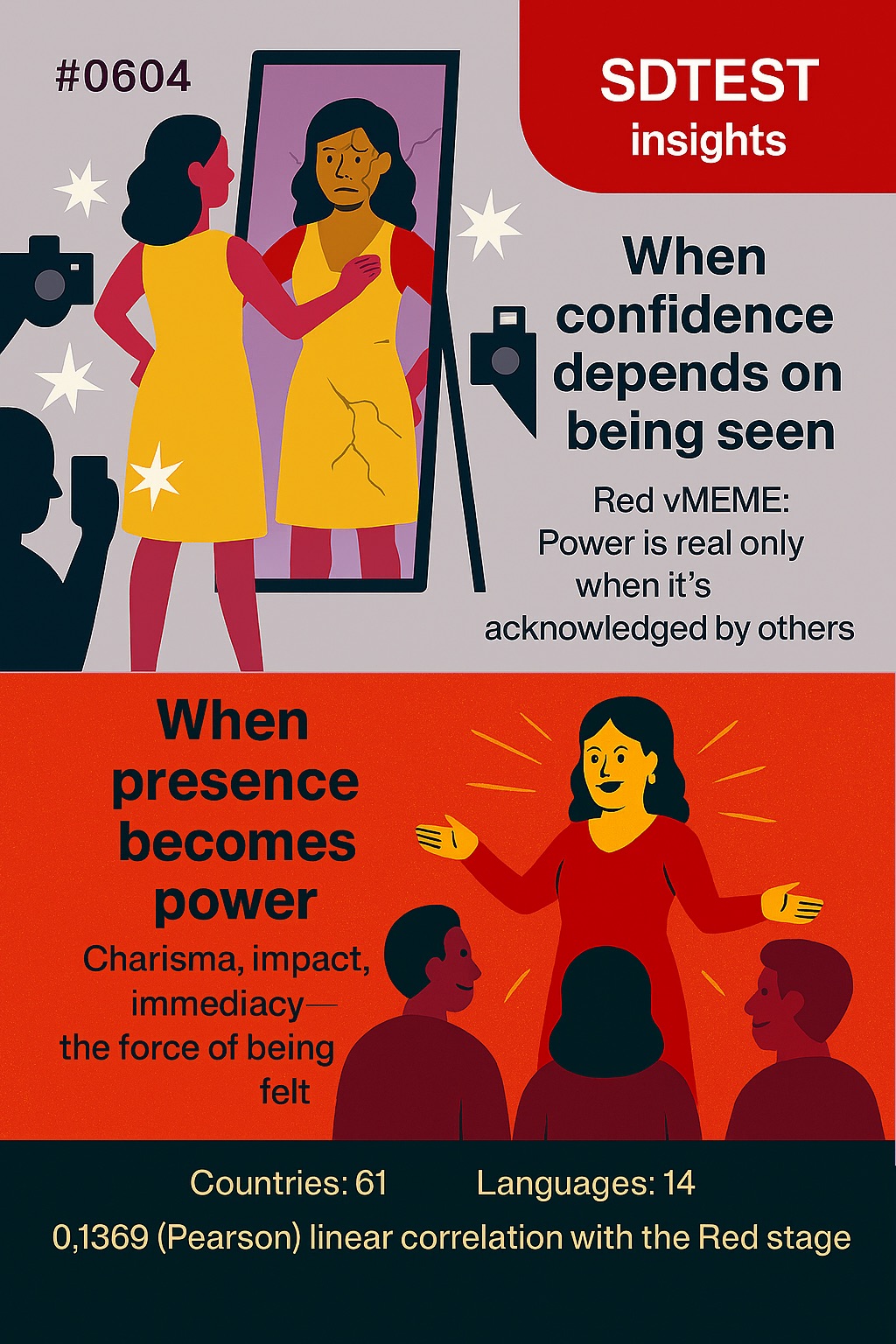
This positive correlation of 0.1369 between "Own attractiveness" and the Red stage offers compelling insights when viewed through the lens of the Red value system:
Organizational Perspective:
Organizations operating within the Red mindset might interpret this correlation as:
- Validation of their understanding that physical dominance and attractive presence directly translate to competitive advantage and power acquisition in business environments
- Confirmation that their aggressive, results-driven culture recognizes attractiveness as a weapon for commanding attention, intimidating rivals, and securing immediate victories
- Evidence supporting their belief that organizational success flows from individual strength and magnetic presence that enables leaders to dominate markets and crush competition
These organizations might respond by:
- Implementing appearance-based hiring and promotion criteria that prioritize physical attractiveness as an indicator of power potential and competitive effectiveness
- Creating image consulting programs that enhance executives' physical presence to maximize their ability to intimidate competitors and command respect
- Establishing performance metrics that reward employees who leverage their attractiveness to win clients, dominate negotiations, and achieve immediate results
Team Perspective:
Teams operating from a Red mindset might approach this correlation by:
- Viewing it as an affirmation of their competitive hierarchy, where attractive team members naturally claim alpha status and leadership roles through physical dominance
- Interpreting it as support for their understanding that team success requires members who can use their attractiveness to assert dominance over rival teams and external threats
- Seeing it as validation for their belief that attractive team members possess inherent power that enables them to fight harder, win more conflicts, and claim greater victories
These teams might respond by:
- Establishing team dynamics where the most attractive members automatically assume leadership positions and receive priority in high-stakes assignments
- Creating competitive environments where team members use their physical appeal to gain advantages over internal rivals and external competitors
- Developing team strategies that leverage attractive members' ability to manipulate, seduce, or intimidate opponents during negotiations and conflicts
Individual Perspective:
Individuals aligned with the Red value system might interpret this correlation as:
- Personal validation of their instinctive understanding that attractiveness provides direct access to power, control, and the ability to dominate others
- Confirmation that their focus on physical appearance serves their desire for immediate gratification and competitive advantage in all confrontations
- Evidence supporting their belief that attractive individuals naturally command respect, fear, and submission from those who lack similar physical presence
These individuals might respond by:
- Actively investing in their physical appearance as a primary strategy for gaining power, winning conflicts, and achieving immediate personal objectives
- Using their attractiveness as a weapon to manipulate others, secure advantages, and assert dominance in professional and personal relationships
- Viewing physical appeal as an essential tool for self-expression and individual superiority that enables them to claim what they want without compromise
This correlation, viewed through the Red lens, suggests that those operating at the Red level may be more likely to prioritize attractiveness as a fundamental component of self-confidence and power. It implies that the Red value system's emphasis on dominance, immediate gratification, and competitive advantage creates natural alignment between physical appeal and personal empowerment.
The reasons why own attractiveness might be important for building self-confidence in the Red stage could include:
- Dominance Display: Attractiveness serves as a visible demonstration of genetic superiority and power that intimidates rivals and commands immediate respect
- Competitive Advantage: Physical appeal provides direct access to resources, opportunities, and victories that fuel Red-stage desires for immediate gratification
- Power Acquisition: Attractive individuals can manipulate, seduce, and control others more effectively, satisfying Red-stage needs for dominance and self-expression
- Instant Validation: Physical attractiveness generates immediate positive responses that feed Red-stage requirements for constant affirmation and superiority confirmation
- Territorial Assertion: Attractive appearance enables individuals to claim and defend their territory, status, and resources through visual dominance and physical presence
This correlation prompts us to consider how power-oriented, competitive value systems influence the relationship between physical appearance and psychological confidence. It raises questions about whether Red-stage individuals experience attractiveness as more directly connected to personal effectiveness and goal achievement compared to other developmental levels.
Ultimately, this correlation highlights the complex interplay between physical appearance, personal power, and competitive advantage. From a Red perspective, prioritizing attractiveness for self-confidence might be seen not as vanity but as a strategic investment in the primary tools of dominance, manipulation, and victory that enable individuals to assert their will and achieve immediate gratification in competitive environments.
0.0418 (Pearson) between the Influential and the Blue stage.
The critical value of the correlation coefficient for a normal distribution, by William Sealy Gosset (Student), is r = 0.0371. Nevertheless, this positive linear correlation of 0.0418 meets the reliability criteria but does not necessarily imply causation.
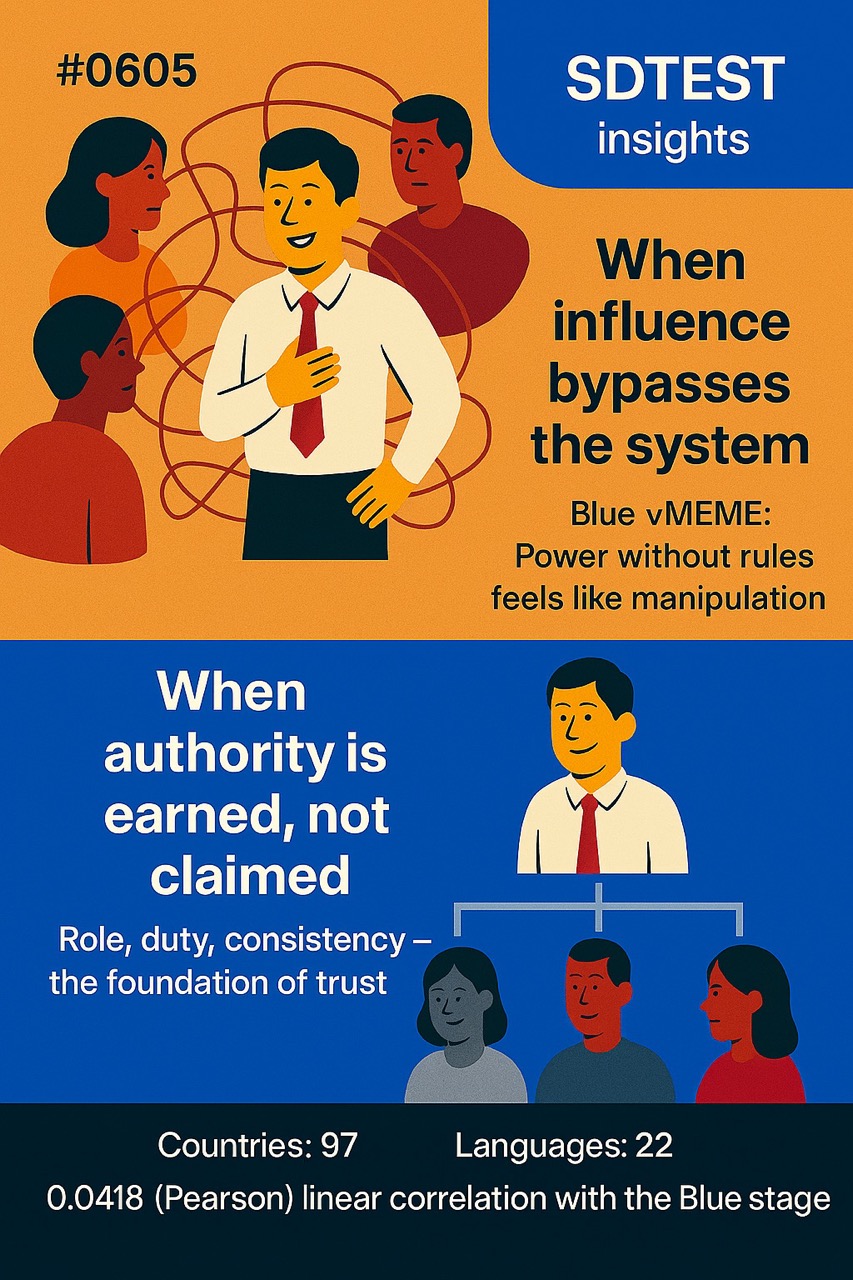
This positive correlation of 0.0418 between "Influential" and the Blue stage offers insights when viewed through the lens of the Blue value system:
Organizational Perspective:
Organizations operating within the Blue mindset might interpret this correlation as:
- Validation of their hierarchical structure, where legitimate influence flows downward from higher authorities who possess divine mandate and moral authority to guide organizational behavior
- Confirmation that their traditional leadership model recognizes influence as the proper means of ensuring adherence to established codes of conduct and institutional values
- Evidence supporting their belief that effective organizational governance requires leaders who can righteously influence others to follow established procedures and moral guidelines
These organizations might respond by:
- Implementing formal training programs that teach leaders how to influence others through proper channels of authority and moral suasion rather than manipulation
- Creating clear protocols for how influence should be exercised within the established hierarchy while maintaining respect for traditional organizational values
- Establishing mentorship systems where senior leaders influence junior members through modeling proper conduct and adherence to institutional moral codes
Team Perspective:
Teams operating from a Blue mindset might approach this correlation by:
- Viewing it as an affirmation of their respect for legitimate authority and the proper use of influence to maintain team order and moral discipline
- Interpreting it as support for their understanding that effective teams require leaders who can righteously influence members to fulfill their duties and responsibilities
- Seeing it as validation for their belief that team success emerges when leaders use their influence to ensure everyone follows established procedures and moral standards
These teams might respond by:
- Establishing clear chains of command where influence operates through proper channels and maintains respect for traditional team hierarchy
- Creating team protocols that define how leaders should appropriately influence team behavior while upholding moral codes and organizational values
- Developing systems where influential team leaders guide others toward dutiful service and adherence to established team principles
Individual Perspective:
Individuals aligned with the Blue value system might interpret this correlation as:
- Personal validation of their respect for legitimate authority and their understanding that proper influence serves moral purposes and institutional order
- Confirmation that their disciplined approach recognizes influence as a sacred responsibility that must be exercised in accordance with traditional values and moral codes
- Evidence supporting their understanding that individual leadership requires the ability to influence others toward righteous behavior and dutiful service
These individuals might respond by:
- Developing their capacity to influence others through moral example and adherence to traditional principles rather than personal manipulation
- Using their influential abilities to guide others toward proper conduct and respect for established authority and institutional values
- Viewing influence as a moral responsibility that requires them to lead others according to divine principles and traditional wisdom
This correlation, viewed through the Blue lens, suggests that those operating at the Blue level may value influence as an essential leadership quality when properly exercised within traditional frameworks. It implies that the Blue value system's emphasis on order, moral authority, and institutional hierarchy creates an understanding that legitimate influence serves to maintain proper conduct and organizational discipline.
The reasons why "Influential" might be important for building successful teams in the Blue stage could include:
- Moral Authority: Influence provides the means to guide team members toward righteous behavior and adherence to established moral codes
- Institutional Order: Leaders need influence to maintain proper hierarchy and ensure everyone fulfills their designated roles and responsibilities
- Duty Enforcement: Influential leaders can ensure team members meet their obligations and follow established procedures without resorting to force
- Traditional Guidance: Influence enables leaders to transmit institutional wisdom and traditional values to team members
- Righteous Direction: Proper influence guides teams toward serving higher purposes and maintaining moral integrity in their work
This correlation prompts us to consider how rule-based, traditional value systems view the relationship between leadership influence and team effectiveness. It raises questions about whether Blue-stage individuals distinguish between legitimate moral influence and inappropriate manipulation in their leadership expectations.
The correlation highlights the interplay between moral frameworks, institutional authority, and leadership effectiveness. From a Blue perspective, valuing influential leadership might reflect understanding that teams require moral guidance and proper authority to maintain order and achieve righteous objectives within established institutional frameworks.
In our analysis of the poll "Why do people procrastinate?", we found an intriguing negative linear correlation that warrants closer examination:
-0.0787 (Pearson) between the Analysis Paralysis: Overthinking or excessive analysis that prevents decision-making and progress / Highly Applicable and the Orange stage.
The critical value of the correlation coefficient for a normal distribution, by William Sealy Gosset (Student), is r = 0.0643. Nevertheless, this negative linear correlation of -0.0787 meets the reliability criteria but does not necessarily imply causation.
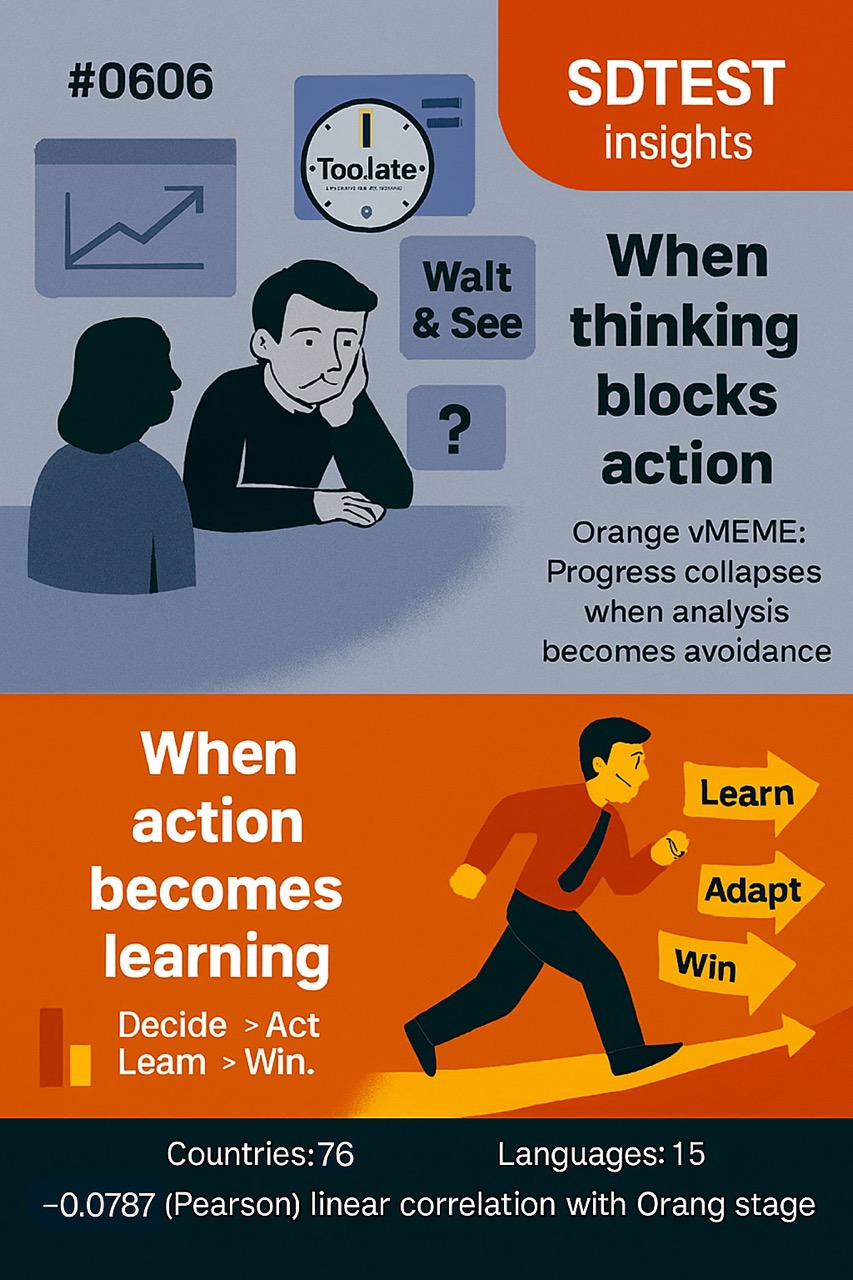
This negative correlation of -0.0787 between "Analysis Paralysis: Overthinking or excessive analysis that prevents decision-making and progress / Highly Applicable" and the Orange stage offers compelling insights when viewed through the lens of the Orange value system:
Organizational Perspective:
Organizations operating within the Orange mindset might interpret this correlation as:
- Validation of their data-driven decision-making frameworks that prioritize rapid hypothesis testing and iterative optimization over prolonged deliberation cycles
- Confirmation that their results-oriented culture creates systematic approaches to analysis that prevent overthinking by establishing clear metrics, deadlines, and decision criteria
- Evidence supporting their belief that scientific methodologies and technological tools enable efficient analysis that transforms complex problems into actionable strategies without excessive delay
These organizations might respond by:
- Implementing agile decision-making frameworks that combine rigorous analysis with time-boxed evaluation periods to prevent analysis from becoming counterproductive
- Developing analytical dashboards and automated reporting systems that provide decision-makers with optimal information density without overwhelming cognitive capacity
- Creating performance incentives that reward timely, evidence-based decisions while maintaining analytical rigor and accountability for measurable outcomes
Team Perspective:
Teams operating from an Orange mindset might approach this correlation by:
- Viewing it as an affirmation of their systematic approach to problem-solving that combines analytical thoroughness with efficient project management and clear deliverable timelines
- Interpreting it as support for their understanding that effective team analysis requires structured methodologies that prevent overthinking while maintaining scientific rigor
- Seeing it as validation for their belief that analytical efficiency emerges through clear role definitions, objective criteria, and technology-enabled collaboration tools
These teams might respond by:
- Establishing analytical workflows that combine comprehensive research with structured decision trees and predetermined evaluation criteria to maintain forward momentum
- Creating team protocols that balance thorough investigation with time management, using project management tools and analytical frameworks to prevent excessive deliberation
- Developing collaborative analysis systems where team members contribute specialized expertise within defined parameters, preventing individual overthinking while maximizing collective intelligence
Individual Perspective:
Individuals aligned with the Orange value system might interpret this correlation as:
- Personal validation of their rational, goal-oriented approach that applies systematic analysis within defined parameters to achieve measurable objectives efficiently
- Confirmation that their scientific thinking creates structured approaches to decision-making that prevent overthinking through clear criteria and evidence-based evaluation
- Evidence supporting their understanding that analytical competence requires balancing thoroughness with efficiency to maintain competitive advantage and personal productivity
These individuals might respond by:
- Developing personal decision-making frameworks that combine analytical rigor with time management, using tools and methodologies that optimize analysis without creating paralysis
- Using their logical thinking to establish clear decision criteria and evaluation timelines that prevent excessive analysis while maintaining scientific validity
- Viewing analytical efficiency as a competitive advantage that demonstrates rational competence and goal-oriented effectiveness in professional environments
This negative correlation, viewed through the Orange lens, suggests that those operating at the Orange level may be less susceptible to analysis paralysis due to their systematic, results-oriented approach to decision-making. It implies that the Orange value system's emphasis on efficiency, scientific methodology, and measurable outcomes creates frameworks that prevent overthinking while maintaining analytical quality.
The reasons why people might not procrastinate due to analysis paralysis in the Orange stage could include:
- Systematic Frameworks: Orange-stage individuals use structured analytical methodologies that prevent endless deliberation through clear decision criteria and time boundaries
- Results Orientation: Focus on measurable outcomes creates urgency that prevents excessive analysis by emphasizing actionable conclusions over perfect information
- Scientific Methodology: Application of evidence-based approaches provides objective criteria for when sufficient analysis has been completed to make valid decisions
- Competitive Pressure: Market-driven mindset creates time sensitivity that prevents overthinking by emphasizing speed-to-market and competitive advantage
- Technological Tools: Use of analytical software and decision-support systems optimizes information processing and prevents cognitive overload that leads to paralysis
This correlation prompts us to consider how rational, achievement-oriented value systems influence approaches to analysis and decision-making. It raises questions about whether Orange-stage individuals have developed more efficient analytical capabilities that balance thoroughness with productivity compared to other developmental levels.
The correlation highlights the interplay between cognitive frameworks, analytical approaches, and decision-making efficiency. From an Orange perspective, avoiding analysis paralysis might reflect a sophisticated understanding that optimal decisions emerge from systematic analysis within defined parameters rather than endless deliberation that prevents measurable progress toward objectives.
In our analysis of the poll "12 ways to build trust with others' (by Justin Wright [2]), we found an intriguing positive linear correlation that warrants closer examination:
0.1295 (Pearson) between the Be kind always (Kindness is the language of trust) / Agree strongly and the Green stage.
The critical value of the correlation coefficient for a normal distribution, by William Sealy Gosset (Student), is r = 0.1142. Nevertheless, this positive linear correlation of 0.1295 meets the reliability criteria but does not necessarily imply causation.
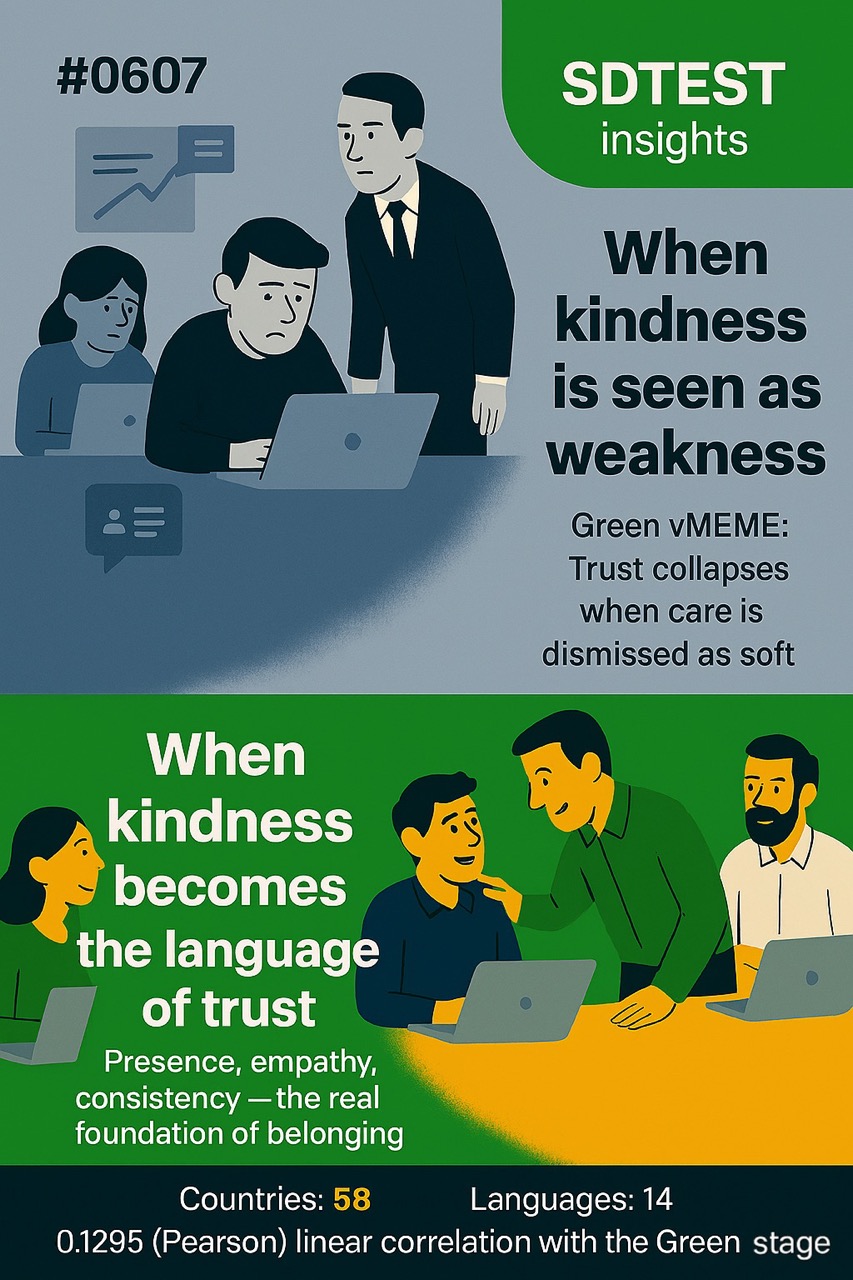
This positive correlation of 0.1295 between strongly agreeing that "Be kind always (Kindness is the language of trust)" and the Green stage offers profound insights when viewed through the lens of the Green value system:
Organizational Perspective:
Organizations operating within the Green mindset might interpret this correlation as:
- Validation of their holistic, people-centered approach to building organizational trust and psychological safety
- Confirmation that their emphasis on compassionate leadership and inclusive decision-making creates sustainable competitive advantages
- Evidence supporting their belief that kindness fosters the collaborative ecosystems necessary for complex problem-solving
These organizations might respond by:
- Implementing comprehensive kindness training programs that integrate emotional intelligence with systems thinking
- Developing trust-building frameworks that prioritize empathy and mutual understanding across all stakeholder relationships
- Creating organizational cultures where kindness is measured and rewarded as a key performance indicator alongside traditional metrics
Team Perspective:
Teams operating from a Green mindset might approach this correlation by:
- Viewing it as an affirmation of their collaborative, consensus-building approach to team dynamics
- Interpreting it as support for their belief that psychological safety through kindness unlocks collective intelligence
- Seeing it as validation for prioritizing long-term relationship building over short-term task completion
These teams might respond by:
- Establishing ritual practices of appreciation and compassionate communication in all team interactions
- Implementing restorative conflict resolution processes that prioritize understanding and healing over winning
- Creating space for vulnerability and authentic sharing as pathways to deeper trust and innovation
Individual Perspective:
Individuals aligned with the Green value system might interpret this correlation as:
- Personal validation of their authentic, empathetic approach to relationship building across all life contexts
- Evidence supporting their belief that kindness creates the interconnected web of trust essential for collective flourishing
- Confirmation of their understanding that individual well-being is inseparable from community well-being
These individuals might respond by:
- Actively cultivating mindfulness practices that enhance their capacity for compassionate presence
- Viewing their commitment to kindness as both personal development and social activism
- Using their understanding of systems thinking to recognize how individual acts of kindness ripple through entire networks
This correlation, viewed through the Green lens, suggests that those operating at the Green level recognize kindness as a fundamental technology for building the trust necessary for complex, interconnected collaboration.
The reasons why "Be kind always" strongly resonates as a trust-building strategy in the Green stage could include:
- Systems Awareness: Understanding that kindness creates positive feedback loops throughout organizational and social ecosystems
- Holistic Integration: Recognizing that trust emerges from the integration of emotional, intellectual, and spiritual dimensions of human connection
- Sustainability Focus: Viewing kindness as essential for creating regenerative rather than extractive organizational cultures
- Collective Intelligence: Understanding that psychological safety through kindness unlocks the collaborative potential necessary for addressing complex challenges
- Authentic Relationships: Recognizing that genuine trust requires vulnerability and compassion rather than transactional exchanges
This correlation prompts us to consider how the Green value system's emphasis on interconnectedness and collective well-being fundamentally reframes trust-building from an individual skill to a systemic practice. It raises questions about how organizations might evolve beyond traditional power dynamics to create genuinely collaborative ecosystems.
Ultimately, this correlation highlights the sophisticated understanding within Green consciousness that kindness is not merely a soft skill but a strategic imperative for navigating the complexity of post-industrial collaboration. Trust becomes not just a means to an end, but a way of being that honors the interconnected nature of all relationships.
In our analysis of the poll "Trust" (by WVS) [Could you tell us how much confidence you have in organizations?], we found an intriguing negative linear correlation that warrants closer examination:
-0.1484 (Pearson) between the North Atlantic Treaty Organization (NATO) / None at all and the Yellow stage.
The critical value of the correlation coefficient for a normal distribution, by William Sealy Gosset (Student), is r = 0.0594. Nevertheless, this negative linear correlation of -0.1484 meets the reliability criteria but does not necessarily imply causation.
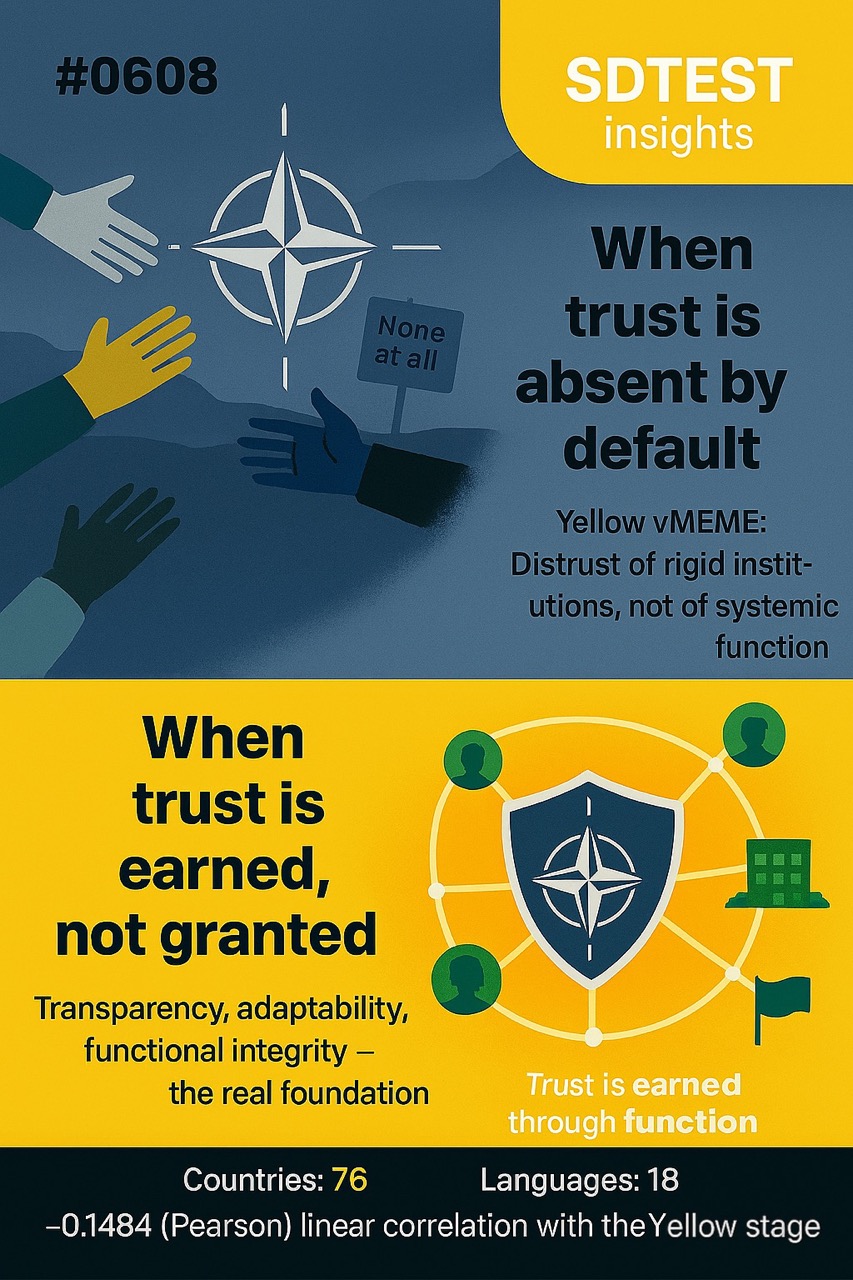
This negative correlation of -0.1484 between expressing "None at all" confidence in NATO and the Yellow stage offers fascinating insights when viewed through the lens of the Yellow value system:
Organizational Perspective:
Organizations operating within the Yellow mindset might interpret this correlation as:
- Validation of their meta-systemic approach to understanding complex geopolitical institutions as necessary components of global stability, even when caught in evolutionary contradictions
- Confirmation that their capacity for integral thinking allows them to diagnose systemic flaws while maintaining functional engagement with imperfect but necessary institutions
- Evidence supporting their belief that dismissing entire institutional systems reflects single-perspective thinking rather than the sophisticated analysis required for adaptive transformation
These organizations might respond by:
- Developing diagnostic frameworks that identify institutional contradictions while simultaneously engaging constructively with their evolutionary potential
- Creating strategic partnerships that leverage institutional knowledge while actively working to resolve systemic paradoxes and adaptive failures
- Implementing decision-making processes that hold the tension between institutional critique and functional necessity, particularly in crises like Ukraine
Team Perspective:
Teams operating from a Yellow mindset might approach this correlation by:
- Viewing it as an affirmation of their capacity to hold paradox when institutions fail to align actions with stated values, as seen in NATO's Ukraine dilemma
- Interpreting it as support for their belief that zero-trust positions prevent the diagnostic work necessary for institutional evolution
- Seeing it as validation for their approach of conditional trust based on performance rather than promises, especially when institutions create "forever frontlines" through strategic limbo
These teams might respond by:
- Establishing protocols for what they call "diagnostic engagement" - simultaneously supporting institutional function while identifying evolutionary bottlenecks
- Creating structured dialogues that explore how institutions like NATO become trapped between founding principles and contemporary geopolitical realities
- Developing capacity for "conditional trust" - maintaining functional relationships while demanding institutional adaptation to moral and strategic imperatives
Individual Perspective:
Individuals aligned with the Yellow value system might interpret this correlation as:
- Personal validation of their meta-cognitive ability to see beyond binary trust/distrust when institutions face existential contradictions
- Evidence supporting their understanding that the greatest threat isn't chaos but systems unable to adapt to their own contradictions
- Confirmation of their capacity to maintain conditional trust that demands institutional alignment between actions and stated values
These individuals might respond by:
- Actively cultivating what they term "diagnostic intelligence" - the ability to simultaneously support and critique institutional performance
- Viewing their nuanced approach to institutional trust as essential for navigating the paradox of supporting Ukraine while critiquing NATO's strategic limbo
- Using their understanding of complex adaptive systems to recognize when institutions require evolutionary pressure to resolve their contradictions
The negative correlation (-0.1484) between "None at all" confidence in NATO and the Yellow vMEME reveals a profound systemic awareness. This isn't about blind loyalty or simplistic distrust; it's about a deep understanding of complex, adaptive systems.
In the context of the war in Ukraine, this correlation takes on even greater significance. Yellow thinkers see the paradox: NATO provides crucial military and political support to Ukraine, effectively engaging in a proxy war with Russia, yet Ukraine stops short of full membership, despite repeated high-level assurances. This creates a strategic limbo, a "forever frontline" where Ukraine bears the existential burden of containing a revisionist power, without the ultimate security guarantee of an alliance.
This isn't seen as mere hypocrisy, but as a systemic flaw: an institution caught between its founding principles of collective defense and the geopolitical risk of direct escalation with a nuclear-armed state. The Yellow vMEME doesn't dismiss NATO; it diagnoses it. It recognizes the functional necessity of the alliance in maintaining a balance of power, while simultaneously critiquing its inability to evolve its own rules to meet the moral and strategic demands of the moment.
The reasons why stronger Yellow vMEME values correlate with less likelihood of expressing zero trust in NATO could include:
- Diagnostic Capacity: Understanding that institutional contradictions require engagement rather than dismissal for evolutionary resolution
- Conditional Trust: Ability to maintain functional relationships while demanding performance-based accountability
- Systemic Paradox Tolerance: Comfort with supporting institutions that simultaneously fulfill necessary functions and exhibit adaptive failures
- Evolutionary Pressure: Recognition that institutions require critical engagement to evolve beyond their founding limitations
- Meta-Systemic Analysis: Capacity to see how institutional paralysis (like NATO's Ukraine dilemma) reflects deeper evolutionary challenges rather than simple failure
The double negation, not having "none at all" confidence, reflects this nuanced stance: trust is not withdrawn, but made conditional. It's trust based on performance, not promises. It's trust that says, "I see your function, I acknowledge your role, but I demand that you align your actions with your stated values."
This correlation prompts us to consider how Yellow consciousness transcends both naive institutional loyalty and categorical dismissal. It raises questions about how diagnostic engagement might catalyze institutional evolution in real-time crises.
Ultimately, this correlation highlights the Yellow value system's sophisticated approach to institutional relationships: maintaining functional engagement while providing evolutionary pressure for adaptive transformation. Because for Yellow, the greatest threat isn't chaos; it's a system that can't adapt to its own contradictions.
-0.1002 (Pearson) between the Be physically active and the Turquoise stage.
The critical value of the correlation coefficient for a normal distribution, by William Sealy Gosset (Student), is r = 0.0615. Nevertheless, this negative linear correlation of -0.1002 meets the reliability criteria but does not necessarily imply causation.

This negative correlation of -0.1002 between "Be physically active" for mental health care and the Turquoise stage offers profound insights when viewed through the lens of the Turquoise value system:
Organizational Perspective:
Organizations operating within the Turquoise mindset might interpret this correlation as:
- Validation of their holistic understanding that mental health transcends the physical-mental dualism embedded in conventional wellness approaches
- Confirmation that their ecological perspective recognizes mental well-being as emerging from interconnected webs of meaning, purpose, and spiritual connection rather than isolated physical interventions
- Evidence supporting their belief that fragmented approaches to wellness reflect mechanistic thinking that fails to honor the integrated nature of human consciousness
These organizations might respond by:
- Developing comprehensive well-being frameworks that integrate contemplative practices, ecological connection, and service to the larger web of life
- Creating workplace cultures that prioritize meaning-making, spiritual development, and alignment with planetary consciousness over traditional fitness-based wellness programs
- Implementing holistic support systems that address mental health through community connection, environmental stewardship, and transcendent purpose rather than individualistic physical activity
Team Perspective:
Teams operating from a Turquoise mindset might approach this correlation by:
- Viewing it as an affirmation of their understanding that collective consciousness and shared purpose provide deeper mental health benefits than individual physical pursuits
- Interpreting it as support for their belief that mental wellness emerges from authentic community, ecological awareness, and service to the greater whole
- Seeing it as validation for prioritizing contemplative practices, nature connection, and collective meaning-making over conventional activity-based wellness approaches
These teams might respond by:
- Establishing ritual practices of collective meditation, nature immersion, and shared visioning as primary mental health interventions
- Creating opportunities for team members to engage in environmental and social healing work as pathways to psychological well-being
- Developing support systems that honor the spiritual dimensions of mental health through community ceremony, ecological connection, and service to planetary evolution
Individual Perspective:
Individuals aligned with the Turquoise value system might interpret this correlation as:
- Personal validation of their understanding that mental health flows from spiritual connection, ecological awareness, and alignment with cosmic purpose
- Evidence supporting their belief that conventional physical activity approaches reflect fragmented thinking that separates body, mind, and spirit
- Confirmation of their experience that true mental wellness emerges from contemplative practices, nature connection, and service to the evolving universe
These individuals might respond by:
- Actively cultivating contemplative practices, ecological communion, and spiritual development as primary pathways to psychological well-being
- Viewing their holistic approach to mental health as part of their larger commitment to planetary and cosmic consciousness
- Using their understanding of interconnectedness to recognize that individual mental health is inseparable from collective and ecological well-being
This correlation, viewed through the Turquoise lens, suggests that those operating at the Turquoise level have transcended mechanistic approaches to mental health, recognizing instead that psychological well-being emerges from spiritual, ecological, and cosmic alignment.
The reasons why "Be physically active" might be less prioritized for mental health care in the Turquoise stage could include:
- Integrated Consciousness: Understanding that mental health cannot be separated from spiritual, ecological, and cosmic dimensions that transcend physical intervention
- Contemplative Primacy: Recognition that contemplative practices, meditation, and inner work provide more profound pathways to psychological well-being than external activity
- Ecological Connection: Belief that mental health flows from an authentic relationship with natural systems rather than from imposed physical routines
- Service Orientation: Understanding that mental wellness emerges from service to the greater whole rather than from self-focused physical improvement
- Transcendent Purpose: Recognition that psychological well-being arises from alignment with evolutionary purpose and cosmic consciousness
- Holistic Integration: Awareness that fragmenting wellness into physical and mental components reflects limited thinking that fails to honor human wholeness
This correlation prompts us to consider how Turquoise consciousness has evolved beyond the body-mind dualism that characterizes earlier developmental approaches to wellness. It raises questions about how post-conventional mental health practices might integrate contemplative, ecological, and service-oriented dimensions.
Ultimately, this correlation highlights the Turquoise value system's recognition that authentic mental health emerges from spiritual development, ecological consciousness, and service to planetary evolution rather than from individualistic physical interventions. Mental wellness becomes not a personal achievement but a natural expression of alignment with the interconnected web of existence, where psychological well-being flows from contemplative practice, nature connection, and dedication to the healing of our world.
What insights do you gain from today's correlation? How might we study this relationship more carefully before deducing causation?
We welcome respectful and wise perspectives! Stay tuned every week as we share more results and insights.
After login or registration, free access to the poll results in the FAQ section.
[1] www.linkedin.com/in/nawal-mustafa-84a90591/
[2] www.linkedin.com/in/wmba
2025.08.31
FearpersonqualitiesprojectorganizationalstructureRACIresponsibilitymatrixCritical ChainProject Managementfocus factorJiraempathyleadersbossGermanyChinaPolicyUkraineRussiawarvolatilityuncertaintycomplexityambiguityVUCArelocatejobproblemcountryreasongive upobjectivekeyresultmathematicalpsychologyMBTIHR metricsstandardDEIcorrelationriskscoringmodelGame TheoryPrisoner's Dilemma
Valerii Kosenko
产品负责人 SaaS SDTEST®
Valerii 于 1993 年获得社会教育心理学家资格,此后将他的知识应用于项目管理。
Valerii 于 2013 年获得硕士学位以及项目和项目经理资格。在硕士学习期间,他熟悉了项目路线图 (GPM Deutsche Gesellschaft für Projektmanagement e. V.) 和 Spiral Dynamics。
Valerii 是探讨 V.U.C.A. 不确定性的作者。使用螺旋动力学和心理学数理统计的概念,以及 38 个国际民意调查。








